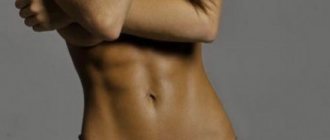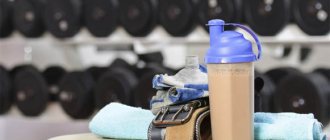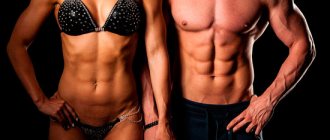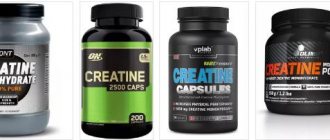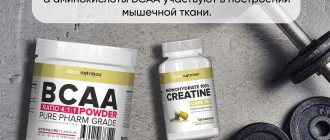Drying the body for men is a time when a man actively trains and selects appropriate nutrition in order to give his body definition. For some men, the process of drawing muscles happens quite quickly and without much effort, while some have to “sweat.”
According to body structure, men can be divided into three types: ectomorphs (thin build with a small percentage of muscle mass, for them drying will take place quickly), mesomorphs (muscular build with a minimum amount of subcutaneous fat, the drying procedure is simplified and most effective in a short period of time), typical endomorphs (muscular build with a lot of subcutaneous fat, the procedure for drawing muscles is lengthy and requires a lot of effort).
The main nuances of drying the body in men
Very often, teenagers and young men during the period of muscle development cannot achieve the desired result, because mistakes were made in drawing up the program, there were errors in the training process or in nutrition. Nutrition for body definition should be aimed at both “mass” and “strength”. During active training, the male body must fully receive the necessary vitamins, minerals, macro- and microelements, otherwise there will be not drying, but a breakdown of muscle mass.
Content:
- The main nuances of drying the body in men
- Rules for drying the body for men
- Nutrition during a diet aimed at drying the male body
- Eligible Products
- Menu for the day
- Menu for the week
The result of an incorrect diet can be not only the loss of muscle tissue, but also disruption of the functioning of all vital systems in the body. With a long-term protein diet, the kidneys and liver are primarily affected.
A diet for drying the body is somewhat different from the usual diets for losing weight. For each day of training, it is recommended to consume a small amount of carbohydrates, and on weekends it is recommended to completely abandon them. Yes, completely eliminating carbohydrates from the diet is an almost impossible mission, since they are present in small dosages in greens, fruits, and vegetables. But it is possible to exclude a larger percentage from the diet (by removing carbohydrates with low GI from the daily menu: vegetables and cereals; carbohydrates with a high GI for the drying procedure and for the male body are completely harmless, but will somewhat slow down the effectiveness of the procedure).
For any athlete during the cutting period, regardless of his body type, he needs to consume one third more protein than he consumed during the muscle building period.
Where to begin
Before you start cutting, you need to weigh yourself and take measurements of body volume, this is necessary in order to track progress, at what speed fat is lost, in which areas this happens better, and what needs to be worked on even more. Weight will show more of a weight trend, whether it goes away or stays the same, because you can also lose muscle.
To track the result you need volume measurements:
- biceps (at the peak of the muscle during contraction);
- chest (at the highest point);
- waist (at the narrowest part);
- abdomen (above the iliac bones);
- hips (at the peak of the circumference);
- legs (along the upper part of the femur);
- shins (on the widest part of the muscles).
Rules for drying the body for men
The procedure for drawing relief on the male body is very labor-intensive, and the effectiveness depends on how correctly the entire complex is performed:
- breakfast is a mandatory meal; if you refuse the morning meal, you can cause a slowdown in metabolic processes;
- five meals a day - you need to eat food every three hours, in small portions, this procedure allows the body to cope with the food that has entered it much faster and at the same time, without storing subcutaneous fat;
- The last meal should be at least two hours before bedtime;
- two-thirds of the total daily ration must be eaten in the first half of the day;
- Sauces, fast food, sweets, and alcohol should be completely excluded from the diet;
- per day you need to drink at least 2 liters of clean, plain water;
- additionally use multivitamins and vitamin complexes;
- For snacks, you should use foods that contain healthy fats: nuts, seeds, dried fruits.
Workout
Power
Strength training while drying should take place in the endurance development mode. Split workouts are performed with supersets of 2 exercises with a large number of repetitions; such workouts can be performed 5 per week.
- Day 1 (chest, back) – 3 supersets (alternating muscle groups) 4x20-25.
- Day 2 (quadriceps) – 2 supersets for the quadriceps, 1 for the lower leg, 4 sets x 20-25.
- Day 3 (biceps, triceps) – 3 supersets (alternating muscle groups) 4x20-25.
- Day 4 (shoulders) – 3 supersets, each for individual delta beams (front, middle, back) 4x20-25.
- Day 5 (femoral biceps, shin) – 2 supersets for the femoral biceps, 1 for the lower leg, 4 sets x 20-25.
Aerobic
To dry your muscles, you must include aerobic exercise - running, interval running, jumping rope, exercise bikes, orbitreks. For proper aerobic exercise, it is necessary to calculate your individual heart rate zone so that you burn fat without losing muscle.
Cardio training while drying can last from 40 to 50 minutes. If you wish, you can do 2 cardio per day - morning and evening for 30 minutes. Before exercising, you should take BCAAs to prevent muscle burning. Such workouts can be performed on a treadmill, orbitrack, exercise bike or stepper.
Jumping rope can be performed a certain number and time - for example, 3000 jumps or for 30 minutes. Or 1 minute of jumping and 1 minute of crunches for the abdominal muscles, and so on for 30 minutes.
Interval running – alternating between walking and running at maximum speed. It is advisable to monitor your heart rate so that it does not decrease when walking, without stopping fat burning. Beginners can perform interval running variations of 1 minute acceleration, 1 minute rest (as well as 2:2, 3:3). More advanced athletes can run in intervals of 5 to 10 minutes. Like other aerobic exercises, you can do 1 workout of 40-50 minutes a day, or 2 workouts of 30 minutes.
Nutrition during a diet aimed at drying the male body
The weekly menu should include:
- proteins - two grams per kilogram of body weight. Proteins should be distributed evenly throughout the day;
- carbohydrates - from two to seven grams per kilogram of body weight (this is with a normal diet), and when eating a dry diet, you need to reduce carbohydrate consumption to a minimum;
- fats - must be included in the diet without fail 0.5 grams per kilogram of body weight.
The approximate number of kilocalories per day for a cutting diet should be 1700-2500.
What sports nutrition is best for weight gain for beginners and professionals?
Why should you supplement your diet and training with special complexes? Despite the fact that a balanced diet allows you to partially compensate for losses and activate the production of your own active substances synthesized by the body, experiments and observations show that this is not enough. The best results, without harm to the body, are achieved only by those who do not neglect the recommendations of experts, using all the best that the sports product market offers today.
Sports nutrition for muscle growth and relief, regardless of the level of fitness of the trainee, allows you to:
- accelerate weight gain and muscle growth;
- quickly remove lactic acid from the body, reducing the time required for recovery, allowing you to increase the intensity and duration of training;
- achieve a clear relief of muscle tissue;
- record an increase in endurance, strength, speed;
- reduce the risk of injury under heavy loads.
Menu for the day
Below is an example of a basic daily menu for a man in the 80+ weight category:
8-00 – one hundred grams of boiled chicken, one hundred grams of buckwheat or rice porridge;
10-00 – four hundred grams of four percent or completely low-fat cottage cheese;
12-00 – three hundred grams of green apples, chopped into pieces;
14-00 – one hundred grams of boiled chicken, one hundred grams of buckwheat or rice porridge;
16-00 – four hundred grams of low-fat cottage cheese;
18-00 – one hundred and fifty grams of boiled chicken, three hundred grams of fresh or stewed vegetables;
20-00 – three hundred grams of protein omelet (do not use proteins in the diet);
22-00 – protein shake or four hundred grams of low-fat cottage cheese;
24-00 – three hundred grams of cottage cheese;
2-00 – sleep.
The menu is provided for a day free from training, since on a training day sports activities can only be done two hours after eating.
Removing water from the body
A sculpted body will never be perfectly contoured; the muscles will not cut as well if a lot of water has accumulated in the athlete’s body. Many people write that drying does not involve getting rid of water, but this is a mistake. Draining the water is the last stage of drying. And throughout the entire process, it is more convenient to monitor your progress when the body copes well with removing excess water.
How to prevent water retention? When drying, you must drink at least 2 liters of water per day (tea, coffee and juices do not count). The more you drink, the better your body removes excess water. If you don't get enough, the body will try to hold it back and you will begin to swell. Your effectiveness in training will also decrease, since a dehydrated person works less intensely.
Substances that affect fluid retention:
- Salt
- Alcohol
- Creatine
- Caffeine
- Sahara
- B vitamins
- Sweets
How to calculate daily calorie intake
The first thing you should do when starting a diet is to calculate your current daily calorie intake.
The amount of energy you consume each day determines your current body weight and body fat—this daily energy requirement is also called your “weight maintenance calorie level.”
Without making any changes to this indicator, you will not notice significant changes in your body. This is exactly the amount of energy you need every day to maintain your weight and stay in the same physical condition.
Ideally, you should aim to reduce your calorie intake by 20%—about 200 to 400 calories below your number. If you can achieve this, you will definitely see results in a couple of weeks.
Since no two people are the same, everyone has a different metabolic rate. These methods are just a rough guide for finding the right level - you'll have to do your own "experimentation" to determine the exact number.
But here are a few different ways to calculate calories. All you have to do is try each one and decide which suits you best...
Method #1 – Instinctive Approach
If your weight has remained the same for a while, then probably the easiest method for calculating calorie levels to maintain your weight without any complex calculations is the instinctive approach.
Provided you maintain the same weight over a long period of time , chances are you are burning as many calories as you consume.
This is great because all you have to do now is write down everything you eat and cut your calories accordingly. You can reduce your portion sizes or replace them with a lower-calorie, but filling option (you'll learn more about this later).
Method #2 – Formula 14 and 17
The 14 17 formula is a simple calculation you can do to determine your approximate calorie level for weight maintenance. This will give you an idea of how much you need to consume daily to reduce body fat.
You need to solve two equations:
- Your body weight (in kilograms) x 14 = A
- Your body weight (in kilograms) x 17 = B
Once you have found A and B, your calorie level for weight maintenance is somewhere between these numbers.
If you have a high metabolism, it will be at the high end of the resulting scale, and if you have a low metabolism, it will be at the lower end.
Take a look at your current calorie intake to see where you fall and what you need to do to reduce that number.
Method #3 – Mifflin-St. George Equation
This is by far one of the most complex methods for determining calorie levels for weight maintenance, but at the same time one of the most reliable: the Mifflin-St. George Equation.
Taking into account numerous factors such as:
- Age;
- Floor;
- Height;
- Weight;
- Level of physical activity.
The equation gives you an accurate estimate of how much you're consuming to maintain your current condition, and then all you have to do is subtract the amount of calories you can tolerate so you can continue exercising and let your body do the rest.
Once you know your daily calorie intake, remember it and try to reduce it gradually every day.
